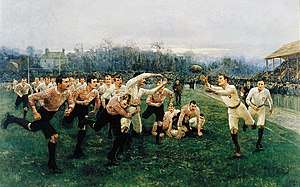The Battle of the Roses
The Battle of the Roses also known as The Rugby Match or The Roses Match is an 1895 portrait by artist William Barnes Wollen. It is based on the rugby union match between the representative sides of Yorkshire and Lancashire played at Park Avenue, Bradford on 25 November 1893. It depicts the Yorkshire team in the all-white strip attacking while the Lancashire team in the hooped red and white jerseys and black shorts try to prevent a pass being made. The action on the pitch takes place in front of a packed stadium.
| The Battle of the Roses | |
|---|---|
| The Rugby Match, The Roses Match | |
 | |
| Artist | William Barnes Wollen |
| Completion date | 1895 |
| Location | Twickenham Stadium, Twickenham, Greater London, England |
| Owner | Yorkshire Rugby Football Union |
History
The identity of the person who commissioned the portrait is unknown but it was completed by Wollen in 1895 and was exhibited at the 1896 Royal Academy Summer Exhibition (catalogue number 673[1]) after which it was sold. It was one of the pieces selected to appear in Cassell's Royal Academy Pictures 1896 edition.[2] It is known to have been on display in West Yorkshire soon after but the subsequent whereabouts of the portrait are unknown until 1957 when members of the Yorkshire Rugby Football Union found the portrait in a second-hand shop in Newcastle. They bought the picture for £25 and it was displayed in the Otley R.U.F.C. clubhouse until the 1960s when it was moved to its current location in the West stand at Twickenham Stadium.[3]
Ghost legend
After the picture was moved to Twickenham it was cleaned and restored. Photographs taken of the picture at this time show that at least one player who has subsequently been overpainted from the picture. One suggestion made was that Wollen painted out players who, in 1895, took part in the schism of rugby and left rugby union to join the Northern Rugby Football Union (later to become the Rugby Football League). The story of these ghosts took root and was repeated as the truth on TV and in the press until it was pointed out that had Wollen painted out all the players who moved codes that there would only be a couple of players left in the picture.[4] Other suggestions are that the painter forgot to include the referee in the original and simply chose to replace one of the players with the referee figure or that the players were expected to make a financial donation to appear in the picture and the one who didn't pay up was removed from the final portrait. None of these suggestions has ever been substantiated and Wollen's motives for the changes are unknown.[3][5]
Accuracy
At least 11 of the players in the picture have been identified as taking part in the 1893 match but others who have been identified didn't, most notably Alf Barraclough, the player making the pass, and Thomas Dobson, the rightmost player in the picture. The referee in the picture has been identified as George Rowland Hill then the secretary of the Rugby Football Union but the actual referee of the game was T Potts from Durham.[5] The game did not take place in weather as good as that depicted either and a contemporary newspaper reported that the game took place in drizzle and then heavier rain which coupled with a strong wind made for the "most miserable" conditions.[6][5]
References
- "The Royal Academy. Second Notice". Edinburgh Evening News (7187). 9 May 1896. p. 4 – via British Newspaper Archive.
- "Literature". Derby Mercury (9467). 17 June 1896. p. 6 – via British Newspaper Archive.
- "The Ghost in the Painting". Rugby History. Rugby Football Union. 14 February 2016. Retrieved 13 December 2017.
- Collins, Tony (1996). "Myth and reality in the 1895 rugby split". The Sports Historian. Routledge. 16 (1): 33. doi:10.1080/17460269609446392.
- Morgan, Piers (1996). "Comment on Myth and reality in the 1895 rugby split by Tony Collins". The Sports Historian. Routledge. 17 (2): 112–113.
- "Lancashire v. Yorkshire. Brilliant White Rose Victory". Leeds Mercury (17, 362). 27 November 1893. p. 3 – via British Newspaper Archive.